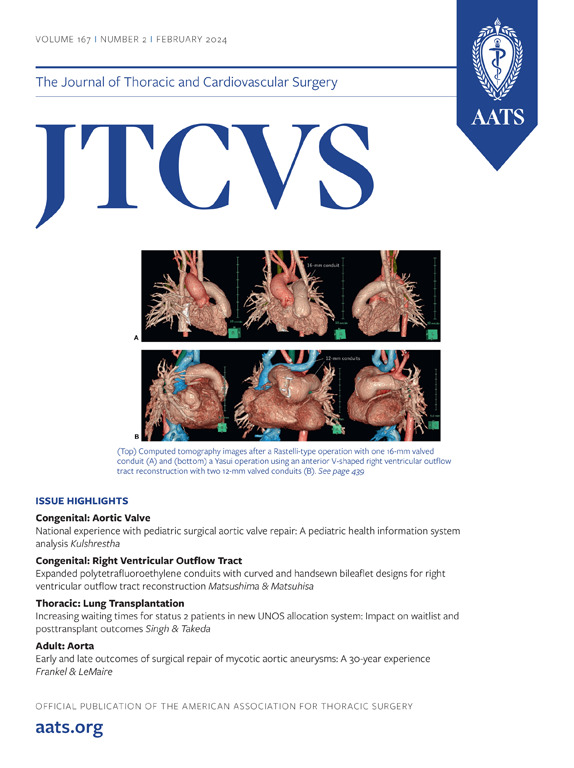566 例微创冠状动脉旁路移植术后的血管重建:有问题吗?
IF 4.4
1区 医学
Q1 CARDIAC & CARDIOVASCULAR SYSTEMS
Journal of Thoracic and Cardiovascular Surgery
Pub Date : 2025-10-01
DOI:10.1016/j.jtcvs.2024.11.020
引用次数: 0
摘要
目的:微创冠状动脉旁路移植术(MICS CABG)可通过一个小的胸前外侧切口,在有或没有心肺旁路的情况下,对所有心肌区域进行可视化和血管再通。作为胸骨切开术 CABG 的一种安全有效的替代方法,它正越来越受欢迎。在本研究中,我们研究了 MICS CABG 患者重复血管再通(RR)的相关性和长期结果:方法:我们每年或每半年对在一家医疗机构接受 MICS CABG 手术的所有患者进行一次前瞻性随访,为期 17 年。考虑到死亡率的竞争风险,我们计算了 RR 的累积发生率。用对数秩检验比较了两组患者 12 年的存活率和免于心源性死亡的 Kaplan-Meier 曲线。采用多变量考克斯比例危险模型来确定与RR相关的变量及其对长期生存的影响:100%的患者(N=566)完成了临床随访,平均随访时间为(7.0±4.4)年。49例(8.7%)患者在MICS CABG术后需要进行RR,12年的累计发生率为(14.8±2.5%)。最常见的适应症是原发性冠状动脉疾病进展,有 23 名患者(占 RR 患者的 46.9%)需要 RR。围手术期输血是唯一与 RR 相关的变量(HR 5.0;95%CI:2.4,10.3)。将有RR和没有RR的患者进行比较,晚期生存率没有显著差异(92.1±4.5% vs. 80.3±3.0%;P=0.18):结论:在17年间接受MICS CABG的566名患者中,RR是一种不常见的事件,影响了8.7%的患者,对长期生存没有负面影响。本文章由计算机程序翻译,如有差异,请以英文原文为准。
Revascularization after minimally invasive coronary artery bypass grafting in 566 patients: Is it a problem?
Objectives
Minimally invasive coronary artery bypass grafting (MICS CABG) allows visualization and revascularization of all myocardial territories through a small anterolateral thoracotomy, with or without cardiopulmonary bypass. It is increasing in popularity as a safe and effective alternative to sternotomy CABG. In this study, we examined the correlates and long-term outcomes of repeat revascularization (RR) in patients who undergo MICS CABG.
Methods
We prospectively followed all patients on an annual or semiannual basis who had undergone MICS CABG surgery over a 17-year period at a single institution. Cumulative incidence of RR was calculated accounting for competing risk of mortality. Kaplan-Meier curves were compared with log-rank test for survival and freedom from cardiac death at 12-years for both groups. Multivariable Cox proportional hazard models were performed to identify variables associated with RR and its impact on long-term survival.
Results
Clinical follow-up was complete for 100% of patients (N = 566) at a mean of 7.0 ± 4.4 years. Forty-nine (8.7%) patients required RR after their MICS CABG, for a cumulative incidence at 12 years of 14.8 ± 2.5%. The most common indication was progression of native coronary disease in 23 (46.9% of RR) patients. Perioperative transfusion was the only variable associated with RR (hazard ratio, 5.0; 95% confidence interval, 2.4-10.3). When we compared patients who had RR with those who did not, there was no significant difference in late survival (92.1 ± 4.5% vs 80.3 ± 3.0%; P = .18).
Conclusions
Among 566 patients who underwent MICS CABG over a 17-year period, RR was an infrequent event affecting 8.7% of patients, with no negative impact on long-term survival.
求助全文
通过发布文献求助,成功后即可免费获取论文全文。
去求助
来源期刊
CiteScore
11.20
自引率
10.00%
发文量
1079
审稿时长
68 days
期刊介绍:
The Journal of Thoracic and Cardiovascular Surgery presents original, peer-reviewed articles on diseases of the heart, great vessels, lungs and thorax with emphasis on surgical interventions. An official publication of The American Association for Thoracic Surgery and The Western Thoracic Surgical Association, the Journal focuses on techniques and developments in acquired cardiac surgery, congenital cardiac repair, thoracic procedures, heart and lung transplantation, mechanical circulatory support and other procedures.

 求助内容:
求助内容: 应助结果提醒方式:
应助结果提醒方式:


